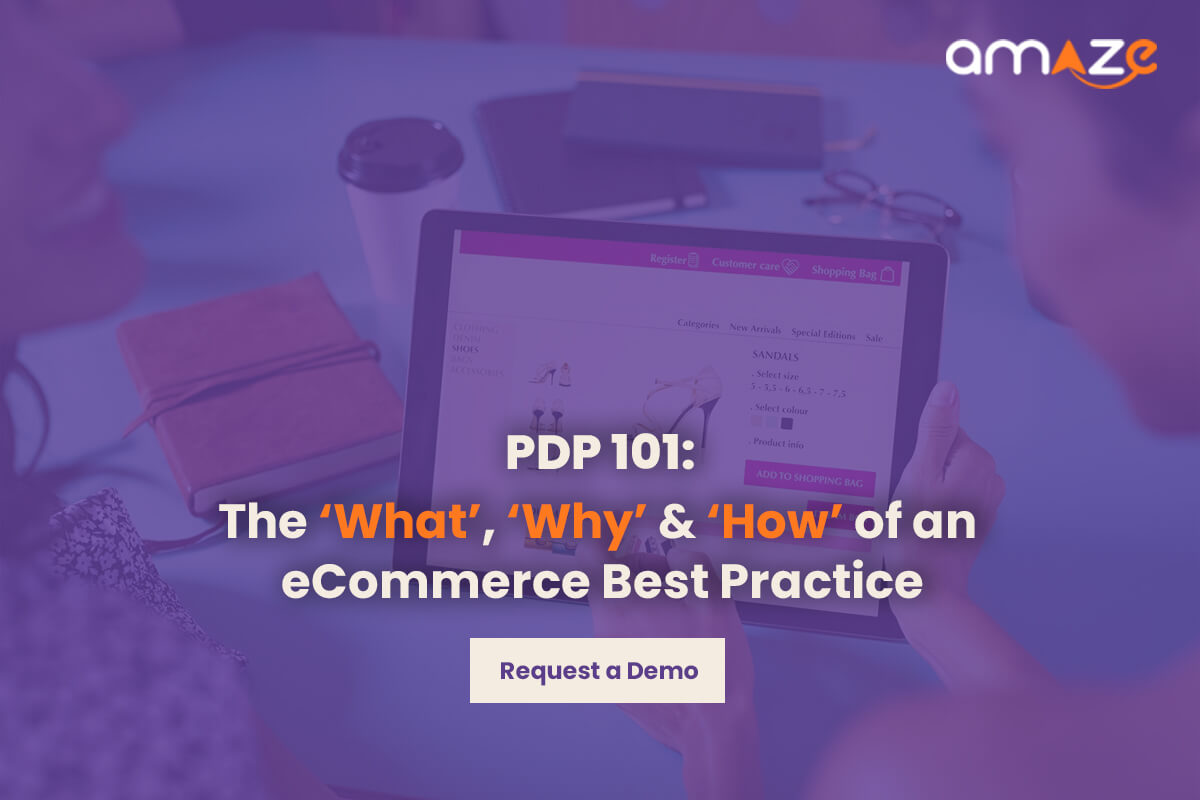PDP 101: The What, Why & How of an eCommerce Best Practice

The product display page (PDP) is most likely the first interaction your customers will have with your brand; so, it better make a lasting impression. While it doesn’t always guarantee a purchase, it certainly does go a long way in nudging the customer in the right direction.
Clichés such as “well begun is half done” are clichés for a reason – more often than not, they are true. And the same goes for your customer’s buying journey. While the product display page (PDP) may not be the first step from the business point of view, it is most likely to be the first point of the customer-brand interaction in the online shopping journey.
WHAT EXACTLY IS A PDP?
Simply put, a PDP, or a product display page, is a page that describes products for customers. It is where you display a product with all supporting information, product attributes and assistance required to purchase a product. Simple? Not really. There are quite a few elements that can be included on a PDP; the trick lies in organizing the product taxonomy and getting all the moving parts aligned to enable a seamless purchase journey. These elements could include everything from the written word to images, videos, illustrations and even gamification. We will discuss these points further down in the blog when we speak about best practices for building an effective product display page
WHY PDPs ARE CENTRAL TO YOUR ECOMMERCE EFFORTS
Product display pages are perhaps the pages where your customers spend most of their time. A compelling PDP, hence, makes it that much more probable to make a sale. Some of the key benefits of well-created PDP pages include:
- Customers get complete and comprehensive information about the products they are interested in
- Engaging content ensures an increase in time spent on page
- All possible questions and doubts about the product are resolved
- It instills customer confidence and trust
- Complete, compelling information drives sales
- SEO efforts get a boost
- Consistent PDP design adds to overall customer experience and brand appeal
- Easier to recommend and cross-sell products
CREATING AN IRRESISTIBLE PDP
Sure, every business would like a PDP that has a ‘love at first sight’ effect on customers. But there’s no single right way of achieving this. You want to ensure that your PDP serves your business objectives while also appealing to the target audience. Additionally, you also want your PDP to be abreast with the latest eCommerce best practices , so you give customers exactly what they expect.
Here are some of the key elements that make up an irresistible PDP:
Product Content
With the power of words, there is a lot you can do. Apart from describing your products completely and accurately with the right set of attributes, you can build an emotional bond with your customers and instill trust and confidence through appealing copy. At the same time, you can also use copy to differentiate your product, explain usability and establish a unique identity. Let’s not forget the role of SEO in all of this. Use the right keywords, but make sure you don’t overstuff your copy at the cost of quality. At the end, the quality of your copy hinges heavily on readability.
Visual elements:
A picture speaks a 1000 words, and videos, perhaps, even more. Make sure you have all the visual elements that best describe your product. Images should be of good quality, and cover different angles, correctly representing scale; videos should express usability; AR experiences should make the product more tangible. Again, it doesn’t hurt to use visual elements to give your PDP a little aesthetic boost. That said, it is pertinent to maintain balance, and not necessarily stuff every available visual technology just because it’s in vogue.
Design:
Design and formatting are what ties your words, visuals, and experiences together. Your PDP should have an intuitive design that’s not just attractive, but also uncluttered and easy to navigate. Even the best content can fall flat if customers don’t understand how to make meaning of all the presented information. The below tips dig a bit deeper into the nuances of building a perfect PDP.
- Navigation Menu:A clean navigation menu helps customers to seamlessly navigate to other parts of your site.
- Taxonomy:Your product is competing with millions of other products when it comes to eCommerce. Search and discovery plays an important role in driving eCommerce success. In eCommerce, having a strong product taxonomy is the crux of your digital merchandising and product discovery strategy.
- Search Bar:Enabling customers to search for more products on your website. While search and navigation may not play an active role in PDP engagement itself, they are vital in overall user experience.
- Breadcrumbs:Indicating the navigation the user followed to reach to that specific page
- Product Name:Use a product title that is true to the product, and also one that is most likely to be used by customer when searching. Avoid names that are too technical. Even if you’re going for something that’s creative or playful, ensure it doesn’t stray too far away from being intuitive – something that a customer will search for.
- Description:While you want to describe your product correctly, don’t dumb it down too much. Instead, use the space to differentiate your product, speaking about use cases and unique factors. Make it SEO friendly with keywords, yet maintain a tone of voice that makes an impact on your target customers.
- Speak directly to your target audience
- Make tangible connections between features and benefits
- Be crafty with jargon; avoid when not necessary, leverage when dealing with specialized target audiences
- Mimic your customer’s vocabulary to engage them
- Features:This is where you get really detailed. List out every relevant feature about the product ensuring that your customer doesn’t need to look elsewhere for these details.
- Attributes:Standardize everything that you can; attributes are the best way to do so. While a description and unique features can be listed out, you also want to list out attributes that may not always be unique, but still are significant in the buying decision.
- Up-To-Date Stock Meters:Make sure your stock status is updated in real time. If customers find an ‘out of stock’ message at the end of the check-out page, they’re not coming back
- SEO Strategy:Keywords play a central role in driving traffic to your website. However, volume alone doesn’t do the trick. Make sure your keywords are relevant and organic to make them truly work, whether you’re using them in product titles, descriptions, features or anywhere else.
- Call to Action:The button should be clear and easy to spot
- Price & Availability:These are two critical factors that drive buying decisions. For example, you don’t want customers getting the ‘out of stock’ message after taking the trouble of going three 3-4 steps before making a purchase.
- Recommendation engines:This enables customers to view other products either by the means of similar products, recently viewed products or ‘shop the look’ options – a great way to cross sell and upsell
- Social proof:Customer reviews, ratings, photos – anything that comes directly from other customers automatically generates more credibility and trust
- FAQ Content:Use FAQs to answer relevant customer queries. This is integral, not just in terms of reducing bounce rates, but also boosting performance on search engine ranking pages (SERPs)
- Meta Content:Make sure your PDP also features SEO-enriched meta descriptions and title tags with brand, product name, model number and other relevant information
- Structured Data: Schema plays an equally important role in driving PDP efficacy. Make sure you use the right type of structured data to enable your product and brand to feature as rich snippets.
- Test Landing Pages:Use testing tools to quantify your landing page efficacy. This will help you identify the right configuration for your business objectives.
- Reduce Page Load Time:Optimize images (size, format), optimize content with breadcrumbs and/or internal linking, reduce redirects and boost the quality of your hosting service. This helps reduce bounce rates and also boosts pages-per-session and subsequent sales
- Periodic Audits:Regularly audit your PDPs for wasted crawl budget, duplicate content, split link equity and other quality deterrents. These may include missing structured data, duplicate meta descriptions and title tags, slow page load time, thin content, broken links, 302 redirects, 404 pages and so on.
COMMON PDP MISTAKES TO AVOID
With all the above considerations, it is still possible to make rudimentary PDP blunders that push your customers away rather than the other way around. Why does this happen? Reasons are plenty, but usually stem from one common issue – an inability to understand what the customer truly needs to turn interest into a concrete purchase decision. PDP designers and creators often find themselves too caught up in little details that don’t matter, and tend to miss the larger picture…the customer. While following the above-mentioned PDP best practices, it is equally important to steer clear of the following missteps.
Unoptimized PDPs
Most customers tend to discontinue shopping on a particular page because they don’t find enough information to support the purchase. Even worse, when they come across information that doesn’t seem reliable, or just doesn’t make sense, credibility of not just the product, but also the brand comes in question. So, while businesses create PDPs, it is critical to have concrete governance measures to ensure information accuracy and completeness.
Then again, the information must also be relevant to the customer. And this is where subject matter expertise is extremely important. Here’s a simple example: A business selling steel sheets for shop work listing out the gauge and strength of the steel is great. However, you would not want to provide the same information when selling a steel fidget spinner, because that particular information (gauge and strength) is of no relevance to the customer.
This is just a simple example of why sense checks are critical to PDP pages. The list of issues that can arise from this basic lack of application goes on and on. And the worst part – customers can see right through them.
Lack of direction
While PDP designers go all-out trying to make pages look aesthetically appealing, it is equally critical to ensure intuitive information flow. As customers read through the PDP, they must intuitively know how to proceed. Alarmingly, a lot of PDPs lack this sense a direction – a direct product of poor UX design.
Scattered information, overwhelming text and image weightage, call-to-action buttons that are confusing or even hard to spot – at the end of the day, even if the customer is interested in buying the product, they may not be able to do so if they don’t understand how to get there. And the time available to sustain this attention and interest is minimal. If customers don’t find the CTA button within a few seconds, you can be rest assured they’re already looking elsewhere for a similar product.
Inconsistency
Inconsistency can creep into a PDP in more ways than one. At the most basic level, factors like product nomenclature can differ across the page, leaving customers unsure of page credibility. A simple example would be calling a product a ‘cap’ in the title, and then calling it a ‘hat’ in the description. This doesn’t just create uncertainty in the customer’s psyche, but also reflects poorly on the brand. On a similar note, attributes and attribute value inconsistency is another major PDP pain point. A simple example:
| Attribute | Attribute Value | |
|---|---|---|
| PDP 1 | Color | Red |
| PDP 2 | Shade | Crimson |
Silly as this may seem, skim through enough PDPs and you’re sure to find many more instances like this one.
Another common consistency issue creeps up between web and mobile experience. No, this is not about homogenizing mobile and web content. In fact, it is usually advisable to design PDPs in keeping with platform and channel requirements. That being said, it is still important to maintain a consistent handwriting across platforms. This includes, but is not restricted to imagery, copy, tone of voice, design sensibilities and so on.
Similarly, inconsistency between PDPs is another commonly noted issue. Websites with differing PDPs for different products exhibit a lack of control of incoming and outgoing content. This, in turn, also says a lot about the quality of the products they’re selling; this is true at least as far as the customer’s PoV is concerned.
Overwhelming Information
While you do want to give your customer all the information they would need to make a purchase decision, balance is key. In the effort to make PDPs appear “populated”, many businesses make the mistake of overstuffing pages with loads of irrelevant information that, in reality, plays little or no part in driving sales. Confusing charts, tons of technical information, redundant images, paragraphs of fluffy descriptions – these are just a few examples of when websites tend to overindulge and miss the big picture.
Half-hearted Engagement
The customer may not like the product they’re seeing. They may even like the product but assume that their purchase journey must end at one purchase. Again, the customer may get an ‘out of stock’ message and hit a dead-end. Challenging as these situations may seem, businesses tend to give up at this point and not make a genuine effort to extended engagement
The last thing businesses need is to leave customers deserted when they’ve generated initial interest. With the ‘out of stock’ example, brands can always explore the possibility of creating a waitlist, or offering similar products. The key is to leverage these challenges and turn them into engagement opportunities.
With so many points to consider, the process of creating a winning PDP may seem daunting to start with. Then again, there may be other specific problems that plague individual businesses from making the most of their PDPs. That said, the effort that goes into creating that perfect PDP is worth it. Businesses know and realize it when they see it translate into improved conversion and sales. So, if you find your business in a similar spot, wondering how to start your journey and create irresistible PDPs for your business, we can help! Reach out to us for a free demo and find out more:
Related Articles
Recent Post
Categories





